A Beginner’s Guide to TrackBack
Originally By: Mena and Ben Trott
This document is an introduction to TrackBack from a non-technical perspective. The goal is to illustrate how the system can be used to enhance cross-site conversations and build community.
What Is TrackBack?
In a nutshell, TrackBack was designed to provide a method of notification between websites: it is a method of person A saying to person B, “This is something you may be interested in.” To do that, person A sends a TrackBack ping to person B.
TrackBack ping: a ping in this context means a small message sent from one webserver to another.
And why would person B be interested in what person A has to say?
- Person A has written a post on his own weblog that comments on a post in Person B’s weblog. This is a form of remote comments—rather than posting the comment directly on Person B’s weblog, Person A posts it on his own weblog, then sends a TrackBack ping to notify Person B.
- Person A has written a post on a topic that a group of people are interested in. This is a form of content aggregation—by sending a TrackBack ping to a central server, visitors can read all posts about that topic. For example, imagine a site which collects weblog posts about Justin Timberlake. Anyone interested in reading about JT could look at this site to keep updated on what other bloggers were saying about his new album, a photo shoot in a magazine, etc.
History
TrackBack was first released as an open specification in August 2002. It was released as both a protocol and as a feature of Movable Type 2.2, which contained the first implementation of TrackBack. Since the true value of TrackBack only comes when many sites support it, TrackBack was always planned as an open system: a system that could be easily implemented in other blogging tools.
To date, TrackBack has been implemented in the following tools:
- Movable Type
- Bloxsom
- Blojsom
- Nucleus
- B2
- Radio
- TrackBack standalone Tool
- WordPress
- Blogger
- In fact, all major blogging tools support TrackBack
How to use TrackBack
Usage of TrackBack is tool-dependent. This section will focus on using TrackBack in Movable Type.
The Bookmarklet
The easiest way to use TrackBack in Movable Type is through the bookmarklet, which uses auto-discovery to discover the list of TrackBack-enabled entries on the page you are reading. (Auto-discovery means that you don’t need to do anything special, because the system will do all of the work for you.) If you haven’t set up a bookmarklet in Movable Type before, it’s easy:
- Log in to Movable Type.
- Click “Set Up Bookmarklets”.
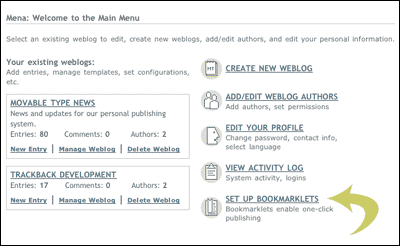
- Configure the bookmarklet display.
Note: Make sure that you check the
TrackBack itemsbox, because this enables the magic discovery of TrackBack-enabled posts. You can select the fields that you would like displayed in the bookmarklet by checking the fields that you want to include. Then clickCreate.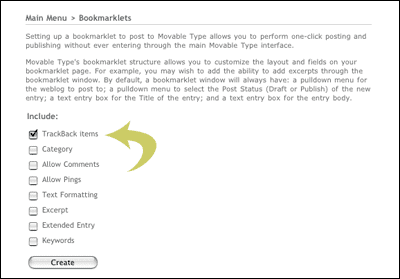
- Install the bookmarklet.
To install the bookmarklet in your web browser, drag the
Post to MT Webloglink to your browser’s Favorites bar.
Once you’ve set up your bookmarklet, you can start using it to post to your Movable Type-powered weblog.
When you read a post that you find interesting on another weblog, click the
Post to MT Weblog button in your Favorites bar to open the bookmarklet.
If there are any TrackBack-enabled posts on the weblog that you’re viewing,
the names of the posts will automatically be added to a pull-down menu under
the heading Select a TrackBack entry to ping:
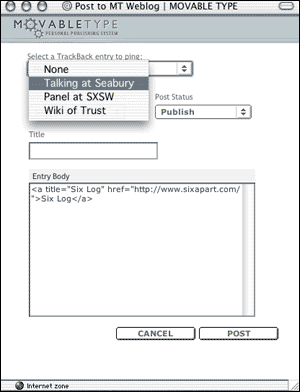
This is what is meant by auto-discovery—the list of TrackBack-enabled posts on the page you are viewing has been automatically extracted for you. You don’t need to do any manual work to figure out which entries are TrackBack-enabled, and you don’t need to find the TrackBack Ping URL for those entries—the system does this automatically for you.
From the menu, select the post that you wish to write about, then write your post in the fields below. Click Post to publish the new post to your weblog. After the post is rebuilt on your weblog, you will see the following screen:
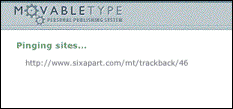
This screen tells you that, in addition to sending pings to update services like blogs.com, Movable Type is sending a TrackBack ping to http://www.sixapart.com/mt/trackback/46.
Click on the screenshot below to watch a 2 minute Quicktime movie about using TrackBack via the bookmarklet. (9 megs)
(Thanks to Brad Choate for mirroring this video.)
The Entry-Editing Form
If you don’t want to use the bookmarklet, you can still use TrackBack in Movable Type—it just won’t be as simple. To use this method, you will need to find the TrackBack Ping URL for the post that you are interested in sending the TrackBack ping to. We’ll describe how to do that in the steps below. Note: the TrackBack Ping URL is not the permalink for an entry—it is a different URL.
- Find a post that you’re interested in.
The first step is obvious: you need something to write about in order to send a TrackBack ping.
The post that you’re interested in writing about needs to be TrackBack-enabled. Weblog posts will usually display a TrackBack link if
they are TrackBack-enabled. For example:
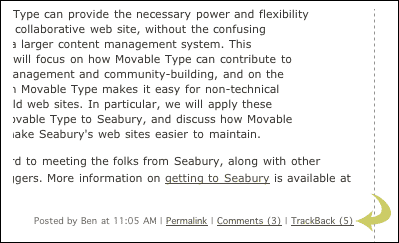
- Find the TrackBack Ping URL.
Click on the TrackBack link to list the TrackBack pings that have been sent to the weblog post you’re interested in, and to find the TrackBack Ping URL. In many blogs, this is listed like this:
 Once you’ve found the URL, copy it.
Once you’ve found the URL, copy it. - Log in to Movable Type.
- Select the weblog that you wish to post to.
- Click New Entry.
- Paste the TrackBack Ping URL into the URLs to Ping field.
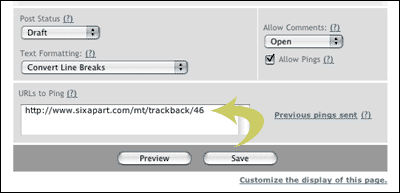 Note: if you don’t see the URLs to Ping field, you may need to click
the Customize the display of this page link to add it to your entry-editing
screen.
Note: if you don’t see the URLs to Ping field, you may need to click
the Customize the display of this page link to add it to your entry-editing
screen. - Compose your entry, and press Save. After your entry has been rebuilt, you will see the Pinging… screen. In addition to the update notification sites like blogs.com, Movable Type will send a TrackBack ping to the URL you entered in URLs to Ping.
Auto-Discovery
A final option for using TrackBack in Movable Type is to enable TrackBack auto-discovery in your weblog configuration preferences:

When you do this, Movable Type will look for any links in your weblog post, and use auto-discovery to determine if those links are TrackBack-enabled. If they are, Movable Type will automatically send TrackBack pings to those sites. You don’t need to use the URLs to Ping field, nor do you need to use the bookmarklet to select TrackBack-enabled posts.
Protocol
TrackBack is a REST-based architecture for peer-to-peer communication and notifications between web sites. The protocol is based on the principle of push, rather than pull—if you want to share information with another website, you initiate the connection, rather than waiting for the other website to discover you (and your information).
Using TrackBack, sites can communicate about related resources. For example, if Weblogger A wishes to notify Weblogger B that he has written something interesting/related/shocking, A sends a TrackBack ping to B. This accomplishes two things:
- Weblogger B can automatically list all sites that have referenced a particular post on his site, allowing visitors to his site to read all related posts around the web, including Weblogger A’s. Automated clients can also get access to this information, enabling them to build a graph of the cross-site conversation.
- The ping provides a firm, explicit link between his entry and yours, as opposed to an implicit link (like a referrer log) that depends upon outside action (someone clicking on the link).
The TrackBack protocol is open for implementation in all weblog tools. The full specification is available at here.
Current Applications
Remote Commenting
Currently, the main use of TrackBack is as a remote commenting system: if I post on my weblog about a post on your weblog, my weblogging tool will notify yours to inform you of that. Your weblog will then display the excerpt of the post that I made, with a link back to the post on my site. This allows visitors to your site (and you) to know what others are saying about your post—like comments, in other words, but the post is on my site instead of yours, as it would be if I had just left a comment. This gives me control over my post. If I want to fix a typo, or change some wording, then I can do that; whereas if I had left a comment on your site, I would not have access to change the text. In other words, TrackBack provides more control over your content.
The power of this method is that the TrackBack ping has created an explicit reference between my site and yours. These references can be utilized to build a diagram of the distributed conversation. Say, for example, that another weblogger posted her thoughts on what I wrote, and sent me a TrackBack ping. The conversation could then be traced from your original post, to my post, then to her post. This threaded conversation can be automatically mapped out using the TrackBack metadata. For example, this thread: http://www.sixapart.com/safari-thread.html. This is a diagram of the conversation started by this weblog post: http://www.sixapart.com/log/2003/01/initial_reactio.shtml.
Content Aggregation
Although TrackBack’s most prevalent use thus far has been as a form of remote commenting, a more exciting use has been emerging: using TrackBack to aggregate content into topic-based repositories. This was actually the original intended use of TrackBack—the remote commenting grew out of a special case of a topic-based repository, the “topic” being a single weblog post.
Content aggregation sites collect content about a particular topic. If you’ve ever tried to look for weblog posts about a particular subject, it’s pretty much impossible to do, unless the subject is a news story or something timely. If your subject is something like 80's Music, you’d have a much more difficult time finding all weblog posts about that subject. This is where TrackBack comes in: by establishing a repository for posts about 80’s Music, other content authors can use TrackBack to automatically ping this central category. Anyone looking for weblog posts about 80’s Music can come to this page to find pointers to such posts.
These content repositories can be either centralized, like the Internet Topic Exchange (http://www.topicexchange.com/), or distributed. In Movable Type, for example, you can set any of your weblog categories to receive TrackBack pings—this enables you to transparently become a source of information on a particular topic of interest to you:
- Log in to Movable Type.
- Select the weblog containing the category you want to TrackBack-enable.
- Click Categories.
- Edit the category attributes. Click the Edit category attributes link for the category that you want to TrackBack-enable.
- Enable TrackBack pings.
Click the On button under Accept incoming TrackBack pings? to enable
incoming TrackBack pings for this category. Then click Save.
- Add a Ping listing to your template. To list the 15 most recent pings to this category in one of your templates, add this code to the template:
- Post the TrackBack URL publicly. In order for others to send TrackBack pings to this category, you’ll need to publicly post the TrackBack URL displayed on the edit category screen:
![]()


In this example, the category name is TrackBack (as we saw above in the editing screenshot). You would need to insert the name of your category instead.

Some examples of sites using TrackBack in this manner:
- Austin Bloggers (http://www.austinbloggers.org/)
- SXSWTrack (http://www.sxswblog.com/sxswTrack.blog)
- BlogPopuli (http://www.blogroots.com/blogpopuli.blog)
Possible Future Uses
Controlling Content
As time goes on and you invest more time and content into your weblog, you will likely want control over all of the content that you post on other blogs and systems. For example, if you post your thoughts about a post on someone else’s weblog, you’ll want to post those thoughts on your own weblog, so that you are in control of them. Or, if you post a review on amazon.com, you may want this review to be syndicated on your own site.
TrackBack can be used to help with this. As an example, Matt Haughey’s Posted Elsewhere sidebar (http://a.wholelottanothing.org/) aggregates content that he has written elsewhere. The reverse would also work: instead of posting the content on someone else’s site, an author could post the content in his own weblog, then send a TrackBack ping to the other site. For example, if amazon.com reviews accepted TrackBack pings, you could control the content on your own site, and let amazon.com link back to you.
